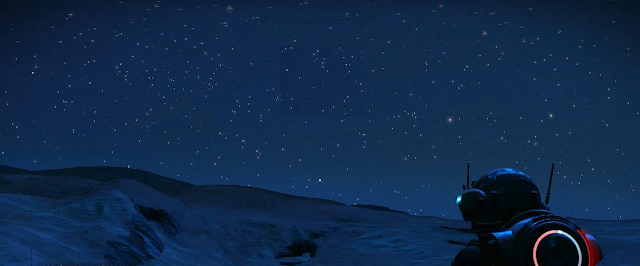The Basic Geography of Rogue Planet
Rogue Planet is, at least on the outside, very dark and very cold. It is in interstellar space, far from the stars that would give orbiting planets warmth and light. It is a spherical planet about 7200km in diameter and with a similar gravitational field to Earth, so humans can at least stand up. On Earth days are measured as the Sun rises and sets in the sky. Similarly a year is how long it takes for the Earth to orbit around the Sun. Rogue Planet has no sun to orbit around, nor is there a sunrise or sunset. Yet it does rotate slowly around an axis, and distant constellations of stars are still visible in the perpetual clear night. By measuring the rise and fall of these stars, the Rogue Planet has a rotation of 66 Earth days or 1585 hours. These distant constellations are the only source of natural light on the surface.
The surface is barren and lifeless, mostly rocks but with clusters of nitrogen and oxygen crystals - it is so cold that these normally gaseous elements freeze. There is only a thin atmosphere of hydrogen, with the occasional pool of liquid helium. Crystals of water ice and methane are also found. There are various impact craters from interstellar asteroids and comets, some of which look large and violent enough to have caused mass extinctions had they happened on Earth. There are also mountain ranges, valleys and canyons.
However, below the surface there is a crust with a honeycomb of tunnels, caves and fissures. Deep abysses drop down deep to the planet's upper mantle, and, similar to Earth, it gets hotter the deeper into the core one travels. The majority of the inside of the rogue planet is pressurised magma, with a radioactive core of iron and unstable elements that provides the heat that keeps the magma molten. Unusually there seems to be little tectonic activity - earthquakes (or here planetquakes) are almost unheard of.
Between the freezing cold of the surface and the infernal heat of the mantle there is a zone within the subterranean caves that can sustain life. This so-called "Goldilocks Zone" is also where liquid water can pool and form its own underground water cycle, trickling down through the rocks and caves, until it heats up enough to evaporate and drift back up to the cooler levels where it condenses and begins its journey back down. The zone for life is approximately from 500m to 3km below the surface. Above 500m and the chill of interstellar space makes it too cold. Below 3km and the molten core is close enough to make things uncomfortably hot.
These cave systems also have an atmosphere that, fortunately, is breathable for humans and other organisms from Earth, composed mainly of nitrogen, helium and oxygen.
The origins of the extensive cavern networks are uncertain. Some are lava tubes, a few are limestone karsts, but many are inexplicable. Some have suggested some sort of rock-digesting bacteria, or maybe deliberate intelligent excavation but the presence of caves and tunnels far more frequent and vast than found on Earth cannot easily be explained.



Comments
Post a Comment